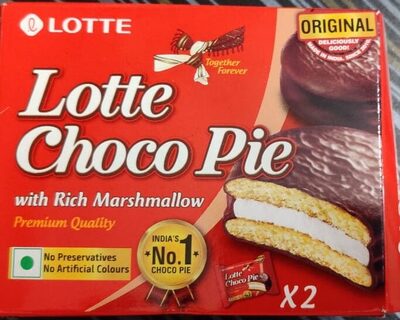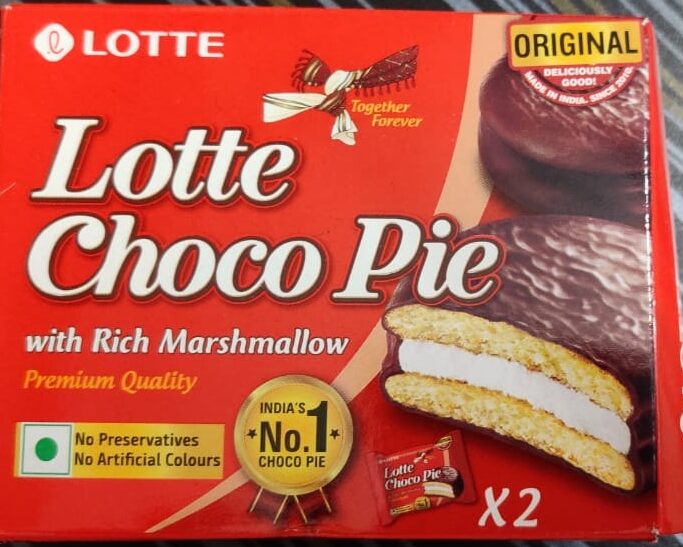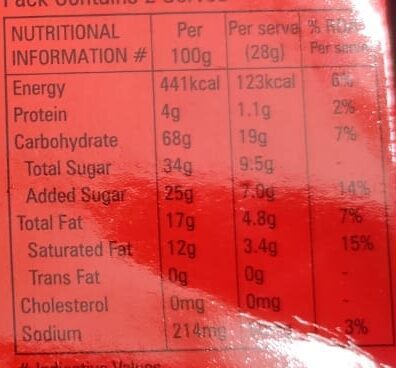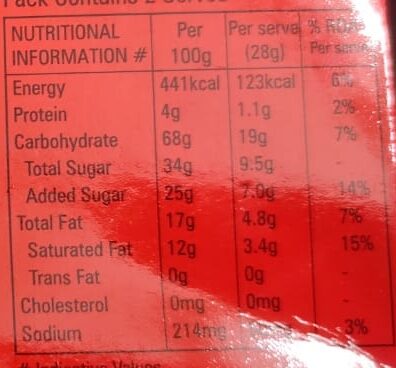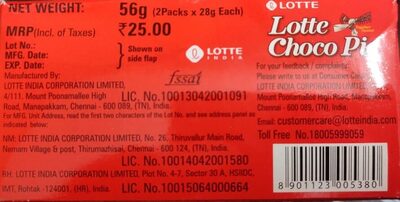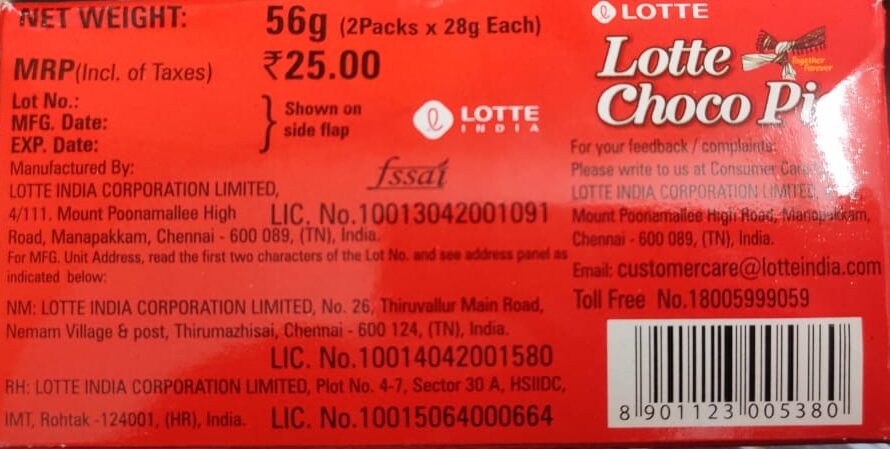Help us make food transparency the norm!
As a non-profit organization, we depend on your donations to continue informing consumers around the world about what they eat.
The food revolution starts with you!
Lotte Choco Pie - 56g
Lotte Choco Pie - 56g
बारकोड: 8901123005380 (EAN / EAN-13)
Common name: Lotte Choco Pie
मात्रा: 56g
पैकेजिंग: en:Plastic
ब्रांड: Lotte
श्रेणियाँ: en:Snacks, en:Sweet snacks, en:Biscuits and cakes, केक
लेबल, प्रमाणपत्र, पुरस्कार: en:No preservatives
Origin of the product and/or its ingredients: Chennai
सामग्री की उत्पत्ति: en:Manapakkam
विनिर्माण या प्रसंस्करण स्थान: Tamil Nadu
Traceability code: HM12G
जिन देशों में बिकता है: भारत
Matching with your preferences
स्वास्थ्य
सामग्री
-
38 ingredients
: REFINED COVERING(21%) [SUGAR, HYDROGENATED VEGETABLE FAT(PALM), COCOA SOLIDS, MILK SOLIDS, EMULSIFIERS (322,476) AND CONTAINS ADDED FLAVOUR-ARTIFICIAL FLAVOURING SUBSTANCE (VANILLA)], SUGAR, LIQUID VEGETABLE FAT (PALM), HUMECTANTS(420, 422), RAISING AGENTS [500(ii), 503(ii)], 1ODISED SALT, DEXTROSE, STABILIZERS (407, 406, 440, 401, 461, 415), MILK SOLIDS AND ACIDITY REGULATOR[341(i)]. CONTAINS ADDED FLAVOUR (ARTIFICIAL FLAVOURING SUBSTANCE - MILK) (Numbers indicated in bracket as per International Numbering System)एलर्जी: en:Milk, en:allergen-information-contains-wheat-gluten, en:interesterified-polyols-may-have-laxative-effects-not-to-be-sold-loose, en:milk-soya-glucose
Food processing
-
Ultra processed foods
Elements that indicate the product is in the en:4 - Ultra processed food and drink products group:
- योज्य: E322
- योज्य: E401
- योज्य: E406 - अगर
- योज्य: E407
- योज्य: E415
- योज्य: E420
- योज्य: E422 - ग्लीसरीन
- योज्य: E440
- योज्य: E461
- योज्य: E476
- Ingredient: Dextrose
- Ingredient: Emulsifier
- Ingredient: Flavouring
- Ingredient: ग्लूकोज़
- Ingredient: Humectant
- Ingredient: Hydrogenated fat
Food products are classified into 4 groups according to their degree of processing:
- Unprocessed or minimally processed foods
- Processed culinary ingredients
- Processed foods
- Ultra processed foods
The determination of the group is based on the category of the product and on the ingredients it contains.
योगशील
-
E322
Lecithin: Lecithin -UK: , US: , from the Greek lekithos, "egg yolk"- is a generic term to designate any group of yellow-brownish fatty substances occurring in animal and plant tissues, which are amphiphilic – they attract both water and fatty substances -and so are both hydrophilic and lipophilic-, and are used for smoothing food textures, dissolving powders -emulsifying-, homogenizing liquid mixtures, and repelling sticking materials.Lecithins are mixtures of glycerophospholipids including phosphatidylcholine, phosphatidylethanolamine, phosphatidylinositol, phosphatidylserine, and phosphatidic acid.Lecithin was first isolated in 1845 by the French chemist and pharmacist Theodore Gobley. In 1850, he named the phosphatidylcholine lécithine. Gobley originally isolated lecithin from egg yolk—λέκιθος lekithos is "egg yolk" in Ancient Greek—and established the complete chemical formula of phosphatidylcholine in 1874; in between, he had demonstrated the presence of lecithin in a variety of biological matters, including venous blood, in human lungs, bile, human brain tissue, fish eggs, fish roe, and chicken and sheep brain. Lecithin can easily be extracted chemically using solvents such as hexane, ethanol, acetone, petroleum ether, benzene, etc., or extraction can be done mechanically. It is usually available from sources such as soybeans, eggs, milk, marine sources, rapeseed, cottonseed, and sunflower. It has low solubility in water, but is an excellent emulsifier. In aqueous solution, its phospholipids can form either liposomes, bilayer sheets, micelles, or lamellar structures, depending on hydration and temperature. This results in a type of surfactant that usually is classified as amphipathic. Lecithin is sold as a food additive and dietary supplement. In cooking, it is sometimes used as an emulsifier and to prevent sticking, for example in nonstick cooking spray.Source: Wikipedia (अंग्रेज़ी भाषा)
-
E341
Calcium phosphate: Calcium phosphate is a family of materials and minerals containing calcium ions -Ca2+- together with inorganic phosphate anions. Some so-called calcium phosphates contain oxide and hydroxide as well. They are white solids of nutritious value.Source: Wikipedia (अंग्रेज़ी भाषा)
-
E406 - अगर
Agar: Agar -pronounced , sometimes - or agar-agar is a jelly-like substance, obtained from red algae.Agar is a mixture of two components: the linear polysaccharide agarose, and a heterogeneous mixture of smaller molecules called agaropectin. It forms the supporting structure in the cell walls of certain species of algae, and is released on boiling. These algae are known as agarophytes, and belong to the Rhodophyta -red algae- phylum.Agar has been used as an ingredient in desserts throughout Asia, and also as a solid substrate to contain culture media for microbiological work. Agar can be used as a laxative, an appetite suppressant, a vegetarian substitute for gelatin, a thickener for soups, in fruit preserves, ice cream, and other desserts, as a clarifying agent in brewing, and for sizing paper and fabrics.The gelling agent in agar is an unbranched polysaccharide obtained from the cell walls of some species of red algae, primarily from tengusa -Gelidiaceae- and ogonori -Gracilaria-. For commercial purposes, it is derived primarily from ogonori. In chemical terms, agar is a polymer made up of subunits of the sugar galactose.Source: Wikipedia (अंग्रेज़ी भाषा)
-
E407
Carrageenan: Carrageenans or carrageenins - karr-ə-gee-nənz, from Irish carraigín, "little rock"- are a family of linear sulfated polysaccharides that are extracted from red edible seaweeds. They are widely used in the food industry, for their gelling, thickening, and stabilizing properties. Their main application is in dairy and meat products, due to their strong binding to food proteins. There are three main varieties of carrageenan, which differ in their degree of sulfation. Kappa-carrageenan has one sulfate group per disaccharide, iota-carrageenan has two, and lambda-carrageenan has three. Gelatinous extracts of the Chondrus crispus -Irish moss- seaweed have been used as food additives since approximately the fifteenth century. Carrageenan is a vegetarian and vegan alternative to gelatin in some applications or may be used to replace gelatin in confectionery.Source: Wikipedia (अंग्रेज़ी भाषा)
-
E415
Xanthan gum: Xanthan gum -- is a polysaccharide with many industrial uses, including as a common food additive. It is an effective thickening agent and stabilizer to prevent ingredients from separating. It can be produced from simple sugars using a fermentation process, and derives its name from the species of bacteria used, Xanthomonas campestris.Source: Wikipedia (अंग्रेज़ी भाषा)
-
E420
Sorbitol: Sorbitol --, less commonly known as glucitol --, is a sugar alcohol with a sweet taste which the human body metabolizes slowly. It can be obtained by reduction of glucose, which changes the aldehyde group to a hydroxyl group. Most sorbitol is made from corn syrup, but it is also found in nature, for example in apples, pears, peaches, and prunes. It is converted to fructose by sorbitol-6-phosphate 2-dehydrogenase. Sorbitol is an isomer of mannitol, another sugar alcohol; the two differ only in the orientation of the hydroxyl group on carbon 2. While similar, the two sugar alcohols have very different sources in nature, melting points, and uses.Source: Wikipedia (अंग्रेज़ी भाषा)
-
E422 - ग्लीसरीन
Glycerol: Glycerol -; also called glycerine or glycerin; see spelling differences- is a simple polyol compound. It is a colorless, odorless, viscous liquid that is sweet-tasting and non-toxic. The glycerol backbone is found in all lipids known as triglycerides. It is widely used in the food industry as a sweetener and humectant and in pharmaceutical formulations. Glycerol has three hydroxyl groups that are responsible for its solubility in water and its hygroscopic nature.Source: Wikipedia (अंग्रेज़ी भाषा)
-
E440
Pectin: Pectin -from Ancient Greek: πηκτικός pēktikós, "congealed, curdled"- is a structural heteropolysaccharide contained in the primary cell walls of terrestrial plants. It was first isolated and described in 1825 by Henri Braconnot. It is produced commercially as a white to light brown powder, mainly extracted from citrus fruits, and is used in food as a gelling agent, particularly in jams and jellies. It is also used in dessert fillings, medicines, sweets, as a stabilizer in fruit juices and milk drinks, and as a source of dietary fiber.Source: Wikipedia (अंग्रेज़ी भाषा)
-
E461
Methyl cellulose: Methyl cellulose -or methylcellulose- is a chemical compound derived from cellulose. It is a hydrophilic white powder in pure form and dissolves in cold -but not in hot- water, forming a clear viscous solution or gel. It is sold under a variety of trade names and is used as a thickener and emulsifier in various food and cosmetic products, and also as a treatment of constipation. Like cellulose, it is not digestible, not toxic, and not an allergen.Source: Wikipedia (अंग्रेज़ी भाषा)
-
E476
Polyglycerol polyricinoleate: Polyglycerol polyricinoleate -PGPR-, E476, is an emulsifier made from glycerol and fatty acids -usually from castor bean, but also from soybean oil-. In chocolate, compound chocolate and similar coatings, PGPR is mainly used with another substance like lecithin to reduce viscosity. It is used at low levels -below 0.5%-, and works by decreasing the friction between the solid particles -e.g. cacao, sugar, milk- in molten chocolate, reducing the yield stress so that it flows more easily, approaching the behaviour of a Newtonian fluid. It can also be used as an emulsifier in spreads and in salad dressings, or to improve the texture of baked goods. It is made up of a short chain of glycerol molecules connected by ether bonds, with ricinoleic acid side chains connected by ester bonds. PGPR is a yellowish, viscous liquid, and is strongly lipophilic: it is soluble in fats and oils and insoluble in water and ethanol.Source: Wikipedia (अंग्रेज़ी भाषा)
-
E500
Sodium carbonate: Sodium carbonate, Na2CO3, -also known as washing soda, soda ash and soda crystals, and in the monohydrate form as crystal carbonate- is the water-soluble sodium salt of carbonic acid. It most commonly occurs as a crystalline decahydrate, which readily effloresces to form a white powder, the monohydrate. Pure sodium carbonate is a white, odorless powder that is hygroscopic -absorbs moisture from the air-. It has a strongly alkaline taste, and forms a moderately basic solution in water. Sodium carbonate is well known domestically for its everyday use as a water softener. Historically it was extracted from the ashes of plants growing in sodium-rich soils, such as vegetation from the Middle East, kelp from Scotland and seaweed from Spain. Because the ashes of these sodium-rich plants were noticeably different from ashes of timber -used to create potash-, they became known as "soda ash". It is synthetically produced in large quantities from salt -sodium chloride- and limestone by a method known as the Solvay process. The manufacture of glass is one of the most important uses of sodium carbonate. Sodium carbonate acts as a flux for silica, lowering the melting point of the mixture to something achievable without special materials. This "soda glass" is mildly water-soluble, so some calcium carbonate is added to the melt mixture to make the glass produced insoluble. This type of glass is known as soda lime glass: "soda" for the sodium carbonate and "lime" for the calcium carbonate. Soda lime glass has been the most common form of glass for centuries. Sodium carbonate is also used as a relatively strong base in various settings. For example, it is used as a pH regulator to maintain stable alkaline conditions necessary for the action of the majority of photographic film developing agents. It acts as an alkali because when dissolved in water, it dissociates into the weak acid: carbonic acid and the strong alkali: sodium hydroxide. This gives sodium carbonate in solution the ability to attack metals such as aluminium with the release of hydrogen gas.It is a common additive in swimming pools used to raise the pH which can be lowered by chlorine tablets and other additives which contain acids. In cooking, it is sometimes used in place of sodium hydroxide for lyeing, especially with German pretzels and lye rolls. These dishes are treated with a solution of an alkaline substance to change the pH of the surface of the food and improve browning. In taxidermy, sodium carbonate added to boiling water will remove flesh from the bones of animal carcasses for trophy mounting or educational display. In chemistry, it is often used as an electrolyte. Electrolytes are usually salt-based, and sodium carbonate acts as a very good conductor in the process of electrolysis. In addition, unlike chloride ions, which form chlorine gas, carbonate ions are not corrosive to the anodes. It is also used as a primary standard for acid-base titrations because it is solid and air-stable, making it easy to weigh accurately.Source: Wikipedia (अंग्रेज़ी भाषा)
-
E503
Ammonium carbonate: Ammonium carbonate is a salt with the chemical formula -NH4-2CO3. Since it readily degrades to gaseous ammonia and carbon dioxide upon heating, it is used as a leavening agent and also as smelling salt. It is also known as baker's ammonia and was a predecessor to the more modern leavening agents baking soda and baking powder. It is a component of what was formerly known as sal volatile and salt of hartshorn.Source: Wikipedia (अंग्रेज़ी भाषा)
Ingredients analysis
-
en:Palm oil
Ingredients that contain palm oil: en:Palm, en:Palm
-
en:Non-vegan
Non-vegan ingredients: en:Hydrogenated vegetable fat, en:Milk solids, en:Milk solids, en:MilkSome ingredients could not be recognized.
We need your help!
You can help us recognize more ingredients and better analyze the list of ingredients for this product and others:
- Edit this product page to correct spelling mistakes in the ingredients list, and/or to remove ingredients in other languages and sentences that are not related to the ingredients.
- Add new entries, synonyms or translations to our multilingual lists of ingredients, ingredient processing methods, and labels.
If you would like to help, join the #ingredients channel on our Slack discussion space and/or learn about ingredients analysis on our wiki. Thank you!
-
en:Vegetarian status unknown
Unrecognized ingredients: en:refined-covering, en:322-476, en:contains-added-flavour-artificial-flavouring-substance, en:420, en:422, en:500, en:ii, en:503, en:ii, en:1odised-salt, en:407, en:406, en:440, en:401, en:461, en:415, en:341, en:i, en:artificial-flavouring-substance, en:numbers-indicated-in-bracket-as-per-international-numbering-systemSome ingredients could not be recognized.
We need your help!
You can help us recognize more ingredients and better analyze the list of ingredients for this product and others:
- Edit this product page to correct spelling mistakes in the ingredients list, and/or to remove ingredients in other languages and sentences that are not related to the ingredients.
- Add new entries, synonyms or translations to our multilingual lists of ingredients, ingredient processing methods, and labels.
If you would like to help, join the #ingredients channel on our Slack discussion space and/or learn about ingredients analysis on our wiki. Thank you!
-
Details of the analysis of the ingredients
We need your help!
Some ingredients could not be recognized.
We need your help!
You can help us recognize more ingredients and better analyze the list of ingredients for this product and others:
- Edit this product page to correct spelling mistakes in the ingredients list, and/or to remove ingredients in other languages and sentences that are not related to the ingredients.
- Add new entries, synonyms or translations to our multilingual lists of ingredients, ingredient processing methods, and labels.
If you would like to help, join the #ingredients channel on our Slack discussion space and/or learn about ingredients analysis on our wiki. Thank you!
: REFINED COVERING 21% (SUGAR, HYDROGENATED VEGETABLE FAT (PALM), COCOA SOLIDS, MILK SOLIDS, EMULSIFIERS (322‚476), CONTAINS ADDED FLAVOUR-ARTIFICIAL FLAVOURING SUBSTANCE (VANILLA)), SUGAR, VEGETABLE FAT (PALM), HUMECTANTS (420, 422), RAISING AGENTS (500 (ii), 503 (ii)), 1ODISED SALT, DEXTROSE, STABILIZERS (407, 406, 440, 401, 461, 415), MILK SOLIDS, ACIDITY REGULATOR (341 (i)), CONTAINS ADDED FLAVOUR (ARTIFICIAL FLAVOURING SUBSTANCE, MILK, Numbers indicated in bracket as per International Numbering System)- REFINED COVERING -> en:refined-covering - percent_min: 21 - percent: 21 - percent_max: 21
- SUGAR -> en:sugar - vegan: yes - vegetarian: yes - ciqual_proxy_food_code: 31016 - percent_min: 3.5 - percent_max: 21
- HYDROGENATED VEGETABLE FAT -> en:hydrogenated-vegetable-fat - vegan: no - vegetarian: maybe - from_palm_oil: maybe - percent_min: 0 - percent_max: 10.5
- PALM -> en:palm - vegan: yes - vegetarian: yes - from_palm_oil: yes - ciqual_food_code: 16129 - percent_min: 0 - percent_max: 10.5
- COCOA SOLIDS -> en:cocoa-solids - vegan: yes - vegetarian: yes - ciqual_proxy_food_code: 18100 - percent_min: 0 - percent_max: 7
- MILK SOLIDS -> en:milk-solids - vegan: no - vegetarian: yes - ciqual_proxy_food_code: 19051 - percent_min: 0 - percent_max: 5.25
- EMULSIFIERS -> en:emulsifier - percent_min: 0 - percent_max: 4.2
- 322‚476 -> en:322-476 - percent_min: 0 - percent_max: 4.2
- CONTAINS ADDED FLAVOUR-ARTIFICIAL FLAVOURING SUBSTANCE -> en:contains-added-flavour-artificial-flavouring-substance - percent_min: 0 - percent_max: 3.5
- VANILLA -> en:vanilla - vegan: yes - vegetarian: yes - percent_min: 0 - percent_max: 3.5
- SUGAR -> en:sugar - vegan: yes - vegetarian: yes - ciqual_proxy_food_code: 31016 - percent_min: 7.9 - percent_max: 21
- VEGETABLE FAT -> en:vegetable-fat - vegan: yes - vegetarian: yes - from_palm_oil: maybe - percent_min: 6.44444444444444 - percent_max: 21
- PALM -> en:palm - vegan: yes - vegetarian: yes - from_palm_oil: yes - ciqual_food_code: 16129 - percent_min: 6.44444444444444 - percent_max: 21
- HUMECTANTS -> en:humectant - percent_min: 4.625 - percent_max: 21
- 420 -> en:420 - percent_min: 2.3125 - percent_max: 21
- 422 -> en:422 - percent_min: 0 - percent_max: 10.5
- RAISING AGENTS -> en:raising-agent - percent_min: 2.28571428571429 - percent_max: 20
- 500 -> en:500 - percent_min: 1.14285714285714 - percent_max: 20
- ii -> en:ii - percent_min: 1.14285714285714 - percent_max: 20
- 503 -> en:503 - percent_min: 0 - percent_max: 10
- ii -> en:ii - percent_min: 0 - percent_max: 10
- 500 -> en:500 - percent_min: 1.14285714285714 - percent_max: 20
- 1ODISED SALT -> en:1odised-salt - percent_min: 0 - percent_max: 16.0473214285714
- DEXTROSE -> en:dextrose - vegan: yes - vegetarian: yes - ciqual_proxy_food_code: 31016 - percent_min: 0 - percent_max: 12.8378571428571
- STABILIZERS -> en:stabiliser - percent_min: 0 - percent_max: 10.6982142857143
- 407 -> en:407 - percent_min: 0 - percent_max: 10.6982142857143
- 406 -> en:406 - percent_min: 0 - percent_max: 5.34910714285714
- 440 -> en:440 - percent_min: 0 - percent_max: 3.56607142857143
- 401 -> en:401 - percent_min: 0 - percent_max: 2.67455357142857
- 461 -> en:461 - percent_min: 0 - percent_max: 2.13964285714286
- 415 -> en:415 - percent_min: 0 - percent_max: 1.78303571428571
- MILK SOLIDS -> en:milk-solids - vegan: no - vegetarian: yes - ciqual_proxy_food_code: 19051 - percent_min: 0 - percent_max: 9.16989795918367
- ACIDITY REGULATOR -> en:acidity-regulator - percent_min: 0 - percent_max: 8.02366071428571
- 341 -> en:341 - percent_min: 0 - percent_max: 8.02366071428571
- i -> en:i - percent_min: 0 - percent_max: 8.02366071428571
- 341 -> en:341 - percent_min: 0 - percent_max: 8.02366071428571
- CONTAINS ADDED FLAVOUR -> en:flavouring - vegan: maybe - vegetarian: maybe - percent_min: 0 - percent_max: 5
- ARTIFICIAL FLAVOURING SUBSTANCE -> en:artificial-flavouring-substance - percent_min: 0 - percent_max: 5
- MILK -> en:milk - vegan: no - vegetarian: yes - ciqual_proxy_food_code: 19051 - percent_min: 0 - percent_max: 2.5
- Numbers indicated in bracket as per International Numbering System -> en:numbers-indicated-in-bracket-as-per-international-numbering-system - percent_min: 0 - percent_max: 1.66666666666667
पोषण
-
Bad nutritional quality
⚠ ️Warning: the amount of fruits, vegetables and nuts is not specified on the label, it was estimated from the list of ingredients: 0This product is not considered a beverage for the calculation of the Nutri-Score.
Positive points: 0
- प्रोटीन: 2 / 5 (मूल्य: 4, rounded value: 4)
- Fiber: 0 / 5 (मूल्य: 0, rounded value: 0)
- Fruits, vegetables, nuts, and colza/walnut/olive oils: 0 / 5 (मूल्य: 0, rounded value: 0)
Negative points: 24
- ऊर्जा: 5 / 10 (मूल्य: 1845, rounded value: 1845)
- शुगर्स: 7 / 10 (मूल्य: 34, rounded value: 34)
- संतृप्त वसा: 10 / 10 (मूल्य: 12, rounded value: 12)
- सोडियम: 2 / 10 (मूल्य: 214, rounded value: 214)
The points for proteins are not counted because the negative points are greater or equal to 11.
Nutritional score: (24 - 0)
Nutri-Score:
-
Nutrient levels
-
वसा in moderate quantity (17%)
What you need to know- A high consumption of fat, especially saturated fats, can raise cholesterol, which increases the risk of heart diseases.
Recommendation: Limit the consumption of fat and saturated fat- Choose products with lower fat and saturated fat content.
-
Saturated fat in high quantity (12%)
What you need to know- A high consumption of fat, especially saturated fats, can raise cholesterol, which increases the risk of heart diseases.
Recommendation: Limit the consumption of fat and saturated fat- Choose products with lower fat and saturated fat content.
-
शर्करा in high quantity (34%)
What you need to know- A high consumption of sugar can cause weight gain and tooth decay. It also augments the risk of type 2 diabetes and cardio-vascular diseases.
Recommendation: Limit the consumption of sugar and sugary drinks- Sugary drinks (such as sodas, fruit beverages, and fruit juices and nectars) should be limited as much as possible (no more than 1 glass a day).
- Choose products with lower sugar content and reduce the consumption of products with added sugars.
-
साधारण नमक in moderate quantity (0.535%)
What you need to know- A high consumption of salt (or sodium) can cause raised blood pressure, which can increase the risk of heart disease and stroke.
- Many people who have high blood pressure do not know it, as there are often no symptoms.
- Most people consume too much salt (on average 9 to 12 grams per day), around twice the recommended maximum level of intake.
Recommendation: Limit the consumption of salt and salted food- Reduce the quantity of salt used when cooking, and don't salt again at the table.
- Limit the consumption of salty snacks and choose products with lower salt content.
-
-
पोषण तथ्य
पोषण तथ्य As sold
for 100 g / 100 mlAs sold
प्रत्येक हिस्सा (1piece * 28g)Compared to: केक ऊर्जा 1,845 kj
(441 kcal)517 kj
(123 kcal)+7% वसा 17 g 4.76 g -7% Saturated fat 12 g 3.36 g +38% Trans fat 17 g 4.76 g +21,392% कोलेस्टेरॉल 0 mg 0 mg -100% Carbohydrates 68 g 19 g +19% शर्करा 34 g 9.52 g +9% Added sugars 25 g 7 g Fiber 0 g 0 g प्रोटीन 4 g 1.12 g -23% साधारण नमक 0.535 g 0.15 g +42% सुषव 0 % vol 0 % vol Fruits‚ vegetables‚ nuts and rapeseed‚ walnut and olive oils (estimate from ingredients list analysis) 0 % 0 %
वातावरण
-
Eco-Score not computed - Unknown environmental impact
We could not compute the Eco-Score of this product as it is missing some data, could you help complete it?Could you add a precise product category so that we can compute the Eco-Score? Add a category
पैकेजिंग
-
Packaging with a medium impact
-
Packaging parts
(Plastic)
-
Packaging materials
Material % Packaging weight Packaging weight per 100 g of product Plastic
-
Transportation
-
Origins of ingredients
Missing origins of ingredients information
⚠ ️ The origins of the ingredients of this product are not indicated.
If they are indicated on the packaging, you can modify the product sheet and add them.
If you are the manufacturer of this product, you can send us the information with our free platform for producers.Add the origins of ingredients for this product Add the origins of ingredients for this product
Threatened species
-
Contains palm oil
Drives deforestation and threatens species such as the orangutan
Tropical forests in Asia, Africa and Latin America are destroyed to create and expand oil palm tree plantations. The deforestation contributes to climate change, and it endangers species such as the orangutan, the pigmy elephant and the Sumatran rhino.
Report a problem
-
Incomplete or incorrect information?
Category, labels, ingredients, allergens, nutritional information, photos etc.
If the information does not match the information on the packaging, please complete or correct it. Open Food Facts is a collaborative database, and every contribution is useful for all.
Data sources
Product added on द्वारा prayagamahathi
Last edit of product page on द्वारा roboto-app.
